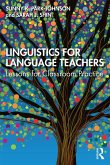- Gebundenes Buch
- Merkliste
- Auf die Merkliste
- Bewerten Bewerten
- Teilen
- Produkt teilen
- Produkterinnerung
- Produkterinnerung
Now in its sixth edition, A Concise Introduction to Linguistics provides students with a detailed introduction to the core concepts of language as it relates to culture. The textbook includes a focus on linguistic anthropology, unpacking the main contributions of linguistics to the study of human communication and culture.
Andere Kunden interessierten sich auch für
![A Concise Introduction to Linguistics A Concise Introduction to Linguistics]() Bruce M. RoweA Concise Introduction to Linguistics98,99 €
Bruce M. RoweA Concise Introduction to Linguistics98,99 €![Introducing English Language Introducing English Language]() Louise Mullany (UK University of Nottingham)Introducing English Language38,99 €
Louise Mullany (UK University of Nottingham)Introducing English Language38,99 €![Everyday Linguistics Everyday Linguistics]() Joanne CavallaroEveryday Linguistics163,99 €
Joanne CavallaroEveryday Linguistics163,99 €![Everyday Linguistics Everyday Linguistics]() Joanne CavallaroEveryday Linguistics47,99 €
Joanne CavallaroEveryday Linguistics47,99 €![The Routledge Introduction to Italian Linguistics The Routledge Introduction to Italian Linguistics]() Cinzia RussiThe Routledge Introduction to Italian Linguistics174,99 €
Cinzia RussiThe Routledge Introduction to Italian Linguistics174,99 €![Understanding Language Understanding Language]() Roger FowlerUnderstanding Language111,99 €
Roger FowlerUnderstanding Language111,99 €![Linguistics for Language Teachers Linguistics for Language Teachers]() Sunny Park-JohnsonLinguistics for Language Teachers39,99 €
Sunny Park-JohnsonLinguistics for Language Teachers39,99 €-
-
-
Now in its sixth edition, A Concise Introduction to Linguistics provides students with a detailed introduction to the core concepts of language as it relates to culture. The textbook includes a focus on linguistic anthropology, unpacking the main contributions of linguistics to the study of human communication and culture.
Hinweis: Dieser Artikel kann nur an eine deutsche Lieferadresse ausgeliefert werden.
Hinweis: Dieser Artikel kann nur an eine deutsche Lieferadresse ausgeliefert werden.
Produktdetails
- Produktdetails
- Verlag: Taylor & Francis Ltd
- 6 ed
- Seitenzahl: 410
- Erscheinungstermin: 30. Dezember 2022
- Englisch
- Abmessung: 216mm x 303mm x 32mm
- Gewicht: 1354g
- ISBN-13: 9781032214252
- ISBN-10: 1032214252
- Artikelnr.: 64647439
- Herstellerkennzeichnung
- Libri GmbH
- Europaallee 1
- 36244 Bad Hersfeld
- gpsr@libri.de
- Verlag: Taylor & Francis Ltd
- 6 ed
- Seitenzahl: 410
- Erscheinungstermin: 30. Dezember 2022
- Englisch
- Abmessung: 216mm x 303mm x 32mm
- Gewicht: 1354g
- ISBN-13: 9781032214252
- ISBN-10: 1032214252
- Artikelnr.: 64647439
- Herstellerkennzeichnung
- Libri GmbH
- Europaallee 1
- 36244 Bad Hersfeld
- gpsr@libri.de
Bruce M. Rowe is a professor emeritus of anthropology at Los Angeles Pierce College, USA, where he has taught since 1970. He designed the college's first linguistics course for students majoring or minoring in linguistics, anthropology, education, English, interpreting for the deaf, and communications studies, and for those fulfilling a general education requirement. Professor Rowe also teaches physical and cultural anthropology as well as sociology. In addition to A Concise Introduction to Linguistics , he has coauthored twelve editions of Physical Anthropology, two editions of Physical Anthropology: The Core, and physical anthropology study guides and workbooks (all with Philip L. Stein-Brian Pierson co-authored the 12th ed. of the Physical Anthropology textbook). Professor Rowe has authored four editions of The College Survival Guide: Hints and References to Aid College Students and The College Awareness Guide: What Students Need to Know to Succeed in College. He has also written 4 children's books on different groups of animals. He has received numerous awards for teaching. He has been a fellow of the American Anthropological Association, a member of the American Association of Physical Anthropologists, the Society for Anthropology in Community Colleges, and the Linguistic Society of America. Diane P. Levine is a professor emerita of anthropology at Los Angeles Pierce College, USA, where she has taught cultural and physical anthropology, as well as linguistics. She was the chair of the Department of Anthropological and Geographical Sciences. As a former teacher of English and English as a second language (ESL), she has written articles on the use of literature in the ESL classroom, and presented seminars on critical thinking in the language arts classroom. Professor Levine was on the advisory board for Annual Editions: Anthropology and was also a national advisor for the Emmy Award-winning film series Cultural Anthropology: Our Diverse World. She is a member of the American Anthropological Association and the Society for Anthropology in Community Colleges. In her retirement she leads archaeology tours for elementary school students at a local museum and tutors middle school students in reading Hebrew.
Preface
1 Introduction: The Nature of Communication
2 Phonetics: The Sounds Used in Languages
3 Phonology: The Sound Patterns Used in Languages
4 Morphology: Words and How they are Formed
5 Syntax: The Larger Patterns of Language
6 Semantics: The Study of Meaning
7 Pragmatics: How Language is Used and The Effect of Context on Meaning
8 Sociolinguistics: Language and Society
9 Linguistic Anthropology: Language and Culture
10 Language Acquisition: How Children (and others) Learn Language
11 Sign Language: The Language of the Deaf Community
12 Writing Systems: The Graphic Representation of Language
13 Nonverbal Communication: Communicating Without Words
14 Historical Linguistics: The History of Languages
Appendix A: Answers to Reviews of Terms and Concepts
Appendix B: Answers to Selected Exercises
Appendix C: Fieldwork Exercises
Appendix D: Chart of full International Phonetic Alphabet (revised 2020)
Glossary
1 Introduction: The Nature of Communication
2 Phonetics: The Sounds Used in Languages
3 Phonology: The Sound Patterns Used in Languages
4 Morphology: Words and How they are Formed
5 Syntax: The Larger Patterns of Language
6 Semantics: The Study of Meaning
7 Pragmatics: How Language is Used and The Effect of Context on Meaning
8 Sociolinguistics: Language and Society
9 Linguistic Anthropology: Language and Culture
10 Language Acquisition: How Children (and others) Learn Language
11 Sign Language: The Language of the Deaf Community
12 Writing Systems: The Graphic Representation of Language
13 Nonverbal Communication: Communicating Without Words
14 Historical Linguistics: The History of Languages
Appendix A: Answers to Reviews of Terms and Concepts
Appendix B: Answers to Selected Exercises
Appendix C: Fieldwork Exercises
Appendix D: Chart of full International Phonetic Alphabet (revised 2020)
Glossary
Preface
1 Introduction: The Nature of Communication
2 Phonetics: The Sounds Used in Languages
3 Phonology: The Sound Patterns Used in Languages
4 Morphology: Words and How they are Formed
5 Syntax: The Larger Patterns of Language
6 Semantics: The Study of Meaning
7 Pragmatics: How Language is Used and The Effect of Context on Meaning
8 Sociolinguistics: Language and Society
9 Linguistic Anthropology: Language and Culture
10 Language Acquisition: How Children (and others) Learn Language
11 Sign Language: The Language of the Deaf Community
12 Writing Systems: The Graphic Representation of Language
13 Nonverbal Communication: Communicating Without Words
14 Historical Linguistics: The History of Languages
Appendix A: Answers to Reviews of Terms and Concepts
Appendix B: Answers to Selected Exercises
Appendix C: Fieldwork Exercises
Appendix D: Chart of full International Phonetic Alphabet (revised 2020)
Glossary
1 Introduction: The Nature of Communication
2 Phonetics: The Sounds Used in Languages
3 Phonology: The Sound Patterns Used in Languages
4 Morphology: Words and How they are Formed
5 Syntax: The Larger Patterns of Language
6 Semantics: The Study of Meaning
7 Pragmatics: How Language is Used and The Effect of Context on Meaning
8 Sociolinguistics: Language and Society
9 Linguistic Anthropology: Language and Culture
10 Language Acquisition: How Children (and others) Learn Language
11 Sign Language: The Language of the Deaf Community
12 Writing Systems: The Graphic Representation of Language
13 Nonverbal Communication: Communicating Without Words
14 Historical Linguistics: The History of Languages
Appendix A: Answers to Reviews of Terms and Concepts
Appendix B: Answers to Selected Exercises
Appendix C: Fieldwork Exercises
Appendix D: Chart of full International Phonetic Alphabet (revised 2020)
Glossary
Preface
1 Introduction: The Nature of Communication
2 Phonetics: The Sounds Used in Languages
3 Phonology: The Sound Patterns Used in Languages
4 Morphology: Words and How they are Formed
5 Syntax: The Larger Patterns of Language
6 Semantics: The Study of Meaning
7 Pragmatics: How Language is Used and The Effect of Context on Meaning
8 Sociolinguistics: Language and Society
9 Linguistic Anthropology: Language and Culture
10 Language Acquisition: How Children (and others) Learn Language
11 Sign Language: The Language of the Deaf Community
12 Writing Systems: The Graphic Representation of Language
13 Nonverbal Communication: Communicating Without Words
14 Historical Linguistics: The History of Languages
Appendix A: Answers to Reviews of Terms and Concepts
Appendix B: Answers to Selected Exercises
Appendix C: Fieldwork Exercises
Appendix D: Chart of full International Phonetic Alphabet (revised 2020)
Glossary
1 Introduction: The Nature of Communication
2 Phonetics: The Sounds Used in Languages
3 Phonology: The Sound Patterns Used in Languages
4 Morphology: Words and How they are Formed
5 Syntax: The Larger Patterns of Language
6 Semantics: The Study of Meaning
7 Pragmatics: How Language is Used and The Effect of Context on Meaning
8 Sociolinguistics: Language and Society
9 Linguistic Anthropology: Language and Culture
10 Language Acquisition: How Children (and others) Learn Language
11 Sign Language: The Language of the Deaf Community
12 Writing Systems: The Graphic Representation of Language
13 Nonverbal Communication: Communicating Without Words
14 Historical Linguistics: The History of Languages
Appendix A: Answers to Reviews of Terms and Concepts
Appendix B: Answers to Selected Exercises
Appendix C: Fieldwork Exercises
Appendix D: Chart of full International Phonetic Alphabet (revised 2020)
Glossary
Preface
1 Introduction: The Nature of Communication
2 Phonetics: The Sounds Used in Languages
3 Phonology: The Sound Patterns Used in Languages
4 Morphology: Words and How they are Formed
5 Syntax: The Larger Patterns of Language
6 Semantics: The Study of Meaning
7 Pragmatics: How Language is Used and The Effect of Context on Meaning
8 Sociolinguistics: Language and Society
9 Linguistic Anthropology: Language and Culture
10 Language Acquisition: How Children (and others) Learn Language
11 Sign Language: The Language of the Deaf Community
12 Writing Systems: The Graphic Representation of Language
13 Nonverbal Communication: Communicating Without Words
14 Historical Linguistics: The History of Languages
Appendix A: Answers to Reviews of Terms and Concepts
Appendix B: Answers to Selected Exercises
Appendix C: Fieldwork Exercises
Appendix D: Chart of full International Phonetic Alphabet (revised 2020)
Glossary
1 Introduction: The Nature of Communication
2 Phonetics: The Sounds Used in Languages
3 Phonology: The Sound Patterns Used in Languages
4 Morphology: Words and How they are Formed
5 Syntax: The Larger Patterns of Language
6 Semantics: The Study of Meaning
7 Pragmatics: How Language is Used and The Effect of Context on Meaning
8 Sociolinguistics: Language and Society
9 Linguistic Anthropology: Language and Culture
10 Language Acquisition: How Children (and others) Learn Language
11 Sign Language: The Language of the Deaf Community
12 Writing Systems: The Graphic Representation of Language
13 Nonverbal Communication: Communicating Without Words
14 Historical Linguistics: The History of Languages
Appendix A: Answers to Reviews of Terms and Concepts
Appendix B: Answers to Selected Exercises
Appendix C: Fieldwork Exercises
Appendix D: Chart of full International Phonetic Alphabet (revised 2020)
Glossary








